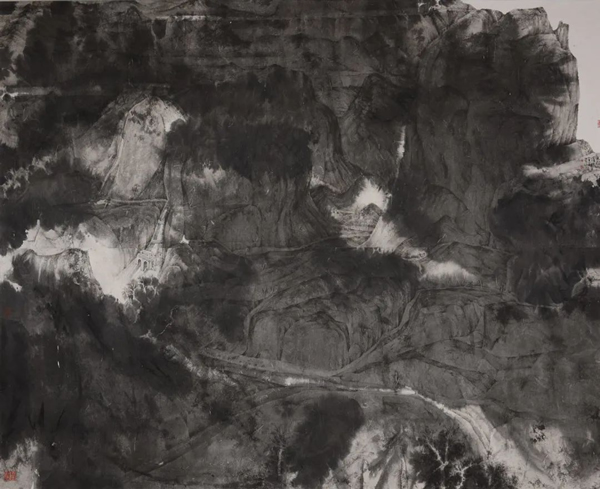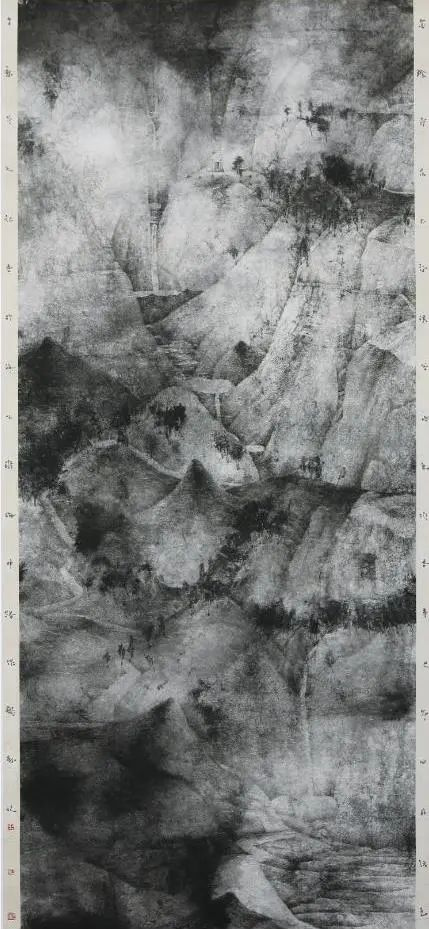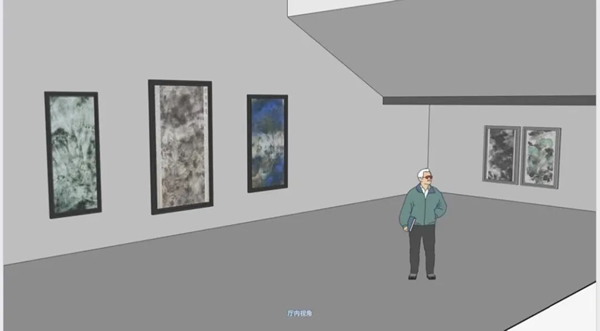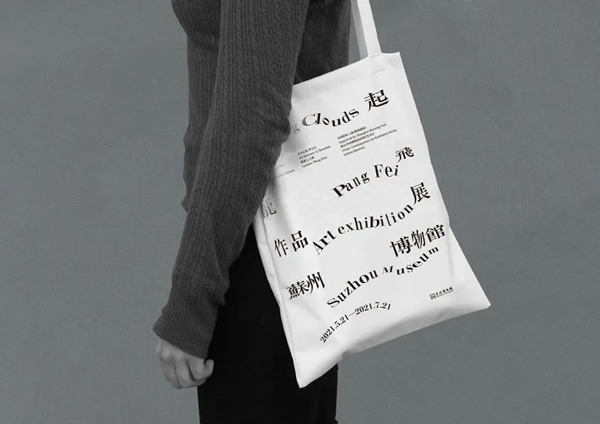展讯 | 云起——庞飞作品展
时间:2021-5-8 9:52:28 来源:海上水墨
石为云根
云起
石出
小满
(辛丑四月初十)

云起——庞飞作品展
Rising Clouds
Art exhibition of Pang Fei
主办:苏州博物馆
Organised by: Suzhou Museum
学术支持:上海中国画院
Academic support: Shanghai Chinese Painting Academy
支持机构:上海《新闻晨报》
Supported by: Shanghai Morning Post
地点:苏州博物馆现代艺术厅
Venue: Contemporary Galleries, Suzhou Museum
时间:2021.5.21-2021.7.21
Duration: 2021.5.21-2021.7.21
鸣谢:上海康茂医疗科技
Acknowledgment:Shanghai Kangmao Medical Technology Co., Ltd

《庞飞:墨》序
文/李小山
几年前,南艺美术馆举办以当代水墨为主题的展览。在选择各地参展艺术家的时候,上海的庞飞进入大家的视野。他的作品展出后好评多多。显然,庞飞并非各类展览的常客。作为上海画院的专业画家,庞飞的优势没有被他自己加以充分“利用”。不过,事物永远是一正一反。庞飞失去的东西在自己的创作里补了回来。换句说,一个专注于自己专业的人或许会失去一些什么,同样,一个把工夫用在专业以外的人或许会获得一些,终局如何?其实每个人心里有一杆秤。千万别小看这杆秤,一个人的分量和价值都显现无误。庞飞属于中生代画家——这一代画家的处境颇有些尴尬。前浪尚未退潮,后浪却又汹汹。所以,庞飞在各种考量之中做了明智的选择。正如他一再对我说的,他希望自己的作品能够做到独特、完整和经得起推敲。

独看云起 136x68cm 2021
创作的奥秘很难用语言来转换。创作与理论隔着一道坚实的围墙。所有对于创作的解读仅仅只是一种肢解。创作永远是一个整体,无法切割成好的部分和差的部分。一个画家只能画出他能画的东西,而不能画出他想画的东西——每个画家都想成为大师、泰斗,即便就常识而论,也是小概率的事。庞飞很清醒,也很实际。他希望自己的作品“经得起推敲”,转化成他本人对作品的反复的深入的推敲。换句话说,庞飞对待作品的态度已到了刻意为之的程度。这是好的。从刻意的推敲到收放自如,这个过程充满魅力。当下许多操持水墨的画家存在着塑造和刻画的短板,美其名曰“意象”“写意”,其实不过是草草了事而已。
水墨画的材料功能具有某种误导性。加上写意画传统的流弊,许多画家放弃了精雕细刻的路径,一头扎进不求形似、逸笔草草的泥潭。请注意,我的意思并不是把精雕细刻奉为圭臬。很多时候,一个画家的造型能力和刻画能力无疑是一种表征,说明其回旋的空间更为广阔,成就自我的可能性更大。因而,我主张庞飞继续深入“推敲”。创作是没有终点的。平庸的的画家全倒在半路上,早早缴械投降——这就是为什么有那么多的画家的艺术生命如此短暂的根源。而出色的画家从来没有尽头,他们追寻过往、当下和未来。他们着迷于未知的东西,在没有路的地方走出了一条路。

太行深处 180x210cm 2017
曾经,我撰文探讨水墨画在当代的种种困境及生存策略。许多年后,我看到水墨画逐渐形成了一个闭环。在这样的闭环里面,一切热闹变成了自嗨行为。而且,这一闭环具有致命的诱惑:自我循环和自我印证诠释了结构性体系的存在方式,它是独立的,自足的,排他的。我不喜欢举所谓的成功者为例,以证明什么途径是对是错。创作是非常个人化的事情,标准掌握在谁手里?我想没有人能够僭越时间这个唯一的权威。某种程度上,每个画家都是自身的主宰,无需听命于任何个人和群体。但是,说起来容易做起来难。在庞飞身上,折射着这个时代的共性。以马克思的说法,人只能在历史提供的条件下创造历史。在这一点上,我和庞飞是一致的。庞飞不奢望奇迹降临,他相信一分汗水一分收获。他也相信自身内部的才华和爆发力,只要方法得当,天赋终究可以挖掘出来。
前不久,庞飞告诉他将在苏州博物馆举办他的个展。在他而言,这是一个重要节点。总结过往,是为了开拓未来。把以往作品完整地展示出来,不失为一个机会,既能够检视自己多年的积累,与各位同道分享;也可以从中找出增加部分或减少部分的办法。我想强调,这个办法并非听取谁谁的意见,以落入邯郸学步的窘境。或许恰恰相反,众说纷纭,倒是庞飞树立信心的基础,拥有更加坚定的自我取向。回到前面所言。庞飞善于推敲,善于刻画和造型。观赏他的作品经常会被画面中的细节所吸引,所打动,显示了作品的耐看和深度。庞飞的主题是山水画——众所周知,山水画作为传统的中坚和主流,聚集了多少天才的心力。可以说,山水画是一种最完备的系统。当代画家对待山水画的方式,无非两种:要么继续传承,要么以破而立。庞飞做过不少实验,在此过程中,他破除了条条框框、陈规陋习。因为,在他的观念里,山水画传统不是金科玉律,画家的当下感受和领悟才是第一义的。

洪谷 200x98cm 2007
庞飞的作品具有比较明显的辨识度,我在很多场合都说过,完美的作品具备三个要素:独特、难度、完成度。将三个要素集积于一身,只是极少数画家的专利。庞飞试图避开山水画的俗套,却仍受限于山水画的对象——山水的自然生成和自然景观。这是一个悖论。庞飞的办法是把画面高度风格化,设计出一种他心目中的山水画图式。庞飞理想里的山水画图式不是古人所谓的“胸中丘壑”,而是被概括、裁剪和整理过的画面。在这样的画面中,山水画的对象性被他设计出来,设计的妙处是个人意愿得以强化,尽量不受或少受套路的干扰。况且,庞飞运用繁复的制作过程,一遍一遍,直到完成。所以,作品的辨识度产生了,同时也顺畅地避开了“笔墨”的问题。笔墨官司自古至今没完没了。争来争去,无非是画地为牢。最终应了一句俗话:田螺壳里做道场。庞飞设法绕开它,在夹缝中求生,边摸索边前行,竟闯出一条路来,不得不说是他的明智和远见。
重复一句老生常谈,艺术没有进步,只有演变。没有谁能够超越古人,超越传统。古人和传统早已经造就辉煌。该做的应是力争不被古人和传统所制约,所遮蔽。我曾与庞飞谈到,如果一个画家获得与古人、与传统比肩的资格,那他一定是开创了属于他自己的天地。这片天地越大,他的成就越大。因此,我寄希望于庞飞,不要左顾右盼,不要停止脚步。我知道他对自己抱有信心。同样,我相信许多人和我一样,也抱有信心。
2021·4·7

Forewords
A few years ago, an exhibition of modern Chinese ink paintings was held at the Art Museum of Nanjing University of the Arts. When we were selecting participating artists, Pang Fei from Shanghai came into view. His works received a lot of accolades after the exhibition. It was apparent that Fei was not a frequent participant in all kinds of exhibitions. As a professional artist at the Shanghai Chinese Painting Academy, Fei has not fully “exploited” his own advantages. Yet there is always the other side of the coin – Fei found what he might have lost in his work. In other words, when an artist who focuses solely on his art loses certain things, and another person who spends less time on art captures certain opportunities, what would be the final result? Everyone could in fact make their own judgement. This is how the real value of an artist would be measured. Pang Fei is among the generation of mid-aged artists – a generation currently in an awkward position. The previous generation were still well-respected, and a new generation has already built their popularity. And Fei has made a correct and smart choice. Just like what he repeatedly told me, he wanted to make sure that his works are unique, complete, and could stand up to scrutiny and critique.
It is difficult to translate artistic creation into words – theories and real creative practices are completely separated. All interpretations of art are compartmentalized. An artistic creation can only be considered as a whole, as there is no way to separate the good and the bad parts. A painter can only paint what he could, not what he wants to paint – every painter wants to become the maestro, a low-probability event by common sense. Fei is very much sober and pragmatic. His goal to “stand up to scrutiny”, has transformed into his repeated “deliberation” of his own work. Fei’s attitude towards his work is very critical. This is good. The process of going from scrutinizing his own work to creativity without boundaries is serious yet charming. There are many ink painting artists right now who promote moody abstract works, but it was only because of their lack of technical training, they simply finish their work in a sloppy way.
The material function of Chinese ink painting is misleading to some extent. With the drawbacks of traditional freehand work, many painters gave up on drawing out meticulous details of the objects, and became careless in accurately reflect the objects’ forms, and casual brushwork. Please note that I do not see that being meticulous is always the right way. Yet an artist’s capabilities of depiction and shaping are often telling indicators of their potential to maneuver and achieve more. This is why I fully support Fei to continue deliberating. There is no end to artistic creation. Mediocre painters go halfway and give up early, which is why many of their artistic lives are so short. Great painters never see the end point. They review the past, the present, and the future. They are obsessed with the unknown and make a path where there is none.
Quite a while ago, I wrote about the difficulties that traditional ink painting faced and proposed strategies for that to survive in the contemporary times. Years later, I see an enclosed loop forming for traditional ink painting – where all excitements were created and consumed among the same group of people in the loop. This loop, at the same time, is deadly attractive, as it is a structured system of self-fulfilling prophecy – it is independent, self-sufficient, and exclusive. I do not like to take successful cases as examples to prove what is right or wrong. Artistic creation is very personalized, and therefore who could set the criteria? I don’t think anyone could overstep the sole authority of the time. Every painter is the master of his or her own to some extent, and he or she answers to no one else. It is easier to say than to practice, however. The character of our time is reflected in Pang Fei. According to Karl Marx, man can only create history, under the condition offered by history. I agree with Fei in this regard. Fei does not wish for a miracle, and he believes in no sweat no gain. He also believes in his talent and energy – which can eventually be discovered over time, with the right method.

Fei told me that he will hold his solo exhibition in Suzhou Museum. This is an important milestone for him, summarizing the past and developing the future. Putting his works completely in exhibit is also an opportunity to review what he had accumulated in the past years, share with fellow painters, and find ways to add something new or take something out from those works. I wanted to emphasize that this is not to take someone’s advice – as it would be awkwardly inauthentic. On the contrary, it will become Fei’s way of strengthening his own confidence with different opinions on his work. He could then have a much firmer and clearer orientation in art. As I have mentioned, Fei is very good at deliberation, at depicting details and forms. Viewing his works, one will often be attracted and touched by the details in the images – enduring and deep works. Fei’s theme is landscape. As we know, landscape is the mainstream in traditional Chinese painting, which has enjoyed many generations of talents and efforts. We could say that Chinese landscape is the most complete system. Our contemporary artists could only treat landscape in two ways, continue inheriting the tradition, or break the boundaries and build a new one. Fei has done many experiments. He had broken rules and bad habits in the meantime. In his view, the traditional rules in landscaping is not absolute truth, and the artist’s feeling and mood are the most important.
Pang Fei’s works are easy to identify. I have said in many occasions that perfect art pieces need to fulfill three criteria: uniqueness, difficulties, and completeness. There are very few artists who could achieve all three. When Fei tries to avoid the stereotypes in landscaping, he still is limited by the objects in his work: the natural view of the mountains and the water. It is a paradox. Fei’s solution is to make the image of his work highly recognizable, with an ideal design of landscape art. It is not what our predecessors called “gullies in your mind”. It is a highly abstract, organized image, that was designed to show a strengthened personalized style, with no, or very little, interference from the routine. Fei’s painting process is very complex. This is how his works become identifiable. It also allows Fei to avoid too many arguments about his achievements in ink and brushwork – an argument in the world of Chinese painting that has been non-stop for centuries, that has only trapped everyone in it. Fei skirted around it and found a new path by feeling his way forward. A very wise move.
At the risk of repeating a cliché, there is no improvement in art; there is only evolvement. No one could go beyond the tradition or transcend the achievements of our ancestors. What we should do, is to strive for new achievements, avoid being restricted and blocked by what our ancestors had done. I told Pang Fei once that if any artist could eventually qualify to be compared with the ancient masters and the tradition, he or she must have created and developed a new area of his or her own. The bigger the area is, the more achievements there are. I would encourage Fei to continue charging on his path without hesitation. I know that he has confidence in himself. And I believe that many others are confident of Fei as well, just like me.
Li Xiaoshan
April 7th, 2021

设计总监:郑邦谦
展览地址:
苏州博物馆
江苏省苏州市姑苏区东北街号
*请自行前往,停车选择周边停车场(拙政园停车场)
非苏州号牌请提前一天申领“姑苏通”通行证
展览详情敬请关注“海上水墨”公众号
(HAISHANG-INK)

姑苏通

海上水墨画院
版权与免责声明:
【声明】本文转载自其它网络媒体,版权归原网站及作者所有;本站发表之图文,均出于非商业性的文化交流和大众鉴赏目的,并不代表赞同其观点和对其真实性负责。如果发现有涉嫌抄袭或不良信息内容,请您告知(电话:17712620144,QQ:476944718,邮件:476944718@qq.com),我们会在第一时间删除。版权所有 2019-2020 上海麟驾艺术品信息有限公司
Copyright 2019-2020 Cnarts.net.cn Incorporated. All rights reserved

|
 |
 |
 |
 |
沪公网安备 31010102006431号 |



